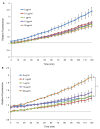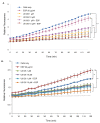Nitric oxide production by Biomphalaria glabrata haemocytes: effects of Schistosoma mansoni ESPs and regulation through the extracellular signal-regulated kinase pathway
- PMID: 19386102
- PMCID: PMC2680853
- DOI: 10.1186/1756-3305-2-18
Nitric oxide production by Biomphalaria glabrata haemocytes: effects of Schistosoma mansoni ESPs and regulation through the extracellular signal-regulated kinase pathway
Abstract
Background: Schistosoma mansoni uses Biomphalaria glabrata as an intermediate host during its complex life cycle. In the snail, the parasite initially transforms from a miracidium into a mother sporocyst and during this process excretory-secretory products (ESPs) are released. Nitric oxide (NO) and its reactive intermediates play an important role in host defence responses against pathogens. This study therefore aimed to determine the effects of S. mansoni ESPs on NO production in defence cells (haemocytes) from schistosome-susceptible and schistosome-resistant B. glabrata strains. As S. mansoni ESPs have previously been shown to inhibit extracellular signal-regulated kinase (ERK) phosphorylation (activation) in haemocytes from susceptible, but not resistant, B. glabrata the regulation of NO output by ERK in these cells was also investigated.
Results: Haemocytes from resistant snails challenged with S. mansoni ESPs (20 mug/ml) over 5 h displayed an increase in NO production that was 3.3 times greater than that observed for unchallenged haemocytes; lower concentrations of ESPs (0.1-10 mug/ml) did not significantly increase NO output. In contrast, haemocytes from susceptible snails showed no significant change in NO output following challenge with ESPs at any concentration used (0.1-20 mug/ml). Western blotting revealed that U0126 (1 muM or 10 muM) blocked the phosphorylation (activation) status of ERK in haemocytes from both snail strains. Inhibition of ERK signalling by U0126 attenuated considerably intracellular NO production in haemocytes from both susceptible and resistant B. glabrata strains, identifying ERK as a key regulator of NO output in these cells.
Conclusion: S. mansoni ESPs differentially influence intracellular NO levels in susceptible and resistant B. glabrata haemocytes, possibly through modulation of the ERK signalling pathway. Such effects might facilitate survival of S. mansoni in its intermediate host.
Figures




Similar articles
-
Differences in the gene expression profiles of haemocytes from schistosome-susceptible and -resistant biomphalaria glabrata exposed to Schistosoma mansoni excretory-secretory products.PLoS One. 2014 Mar 24;9(3):e93215. doi: 10.1371/journal.pone.0093215. eCollection 2014. PLoS One. 2014. PMID: 24663063 Free PMC article.
-
Larval excretory-secretory products from the parasite Schistosoma mansoni modulate HSP70 protein expression in defence cells of its snail host, Biomphalaria glabrata.Cell Stress Chaperones. 2010 Sep;15(5):639-50. doi: 10.1007/s12192-010-0176-z. Epub 2010 Feb 25. Cell Stress Chaperones. 2010. PMID: 20182834 Free PMC article.
-
Disruption of ERK signalling in Biomphalaria glabrata defence cells by Schistosoma mansoni: implications for parasite survival in the snail host.Dev Comp Immunol. 2008;32(12):1561-71. doi: 10.1016/j.dci.2008.05.014. Epub 2008 Jun 20. Dev Comp Immunol. 2008. PMID: 18619674
-
Epigenetic modulation, stress and plasticity in susceptibility of the snail host, Biomphalaria glabrata, to Schistosoma mansoni infection.Int J Parasitol. 2016 Jun;46(7):389-94. doi: 10.1016/j.ijpara.2016.03.003. Epub 2016 Apr 4. Int J Parasitol. 2016. PMID: 27056272 Review.
-
Are Biomphalaria snails resistant to Schistosoma mansoni?J Helminthol. 2005 Sep;79(3):187-91. doi: 10.1079/joh2005299. J Helminthol. 2005. PMID: 16153311 Review.
Cited by
-
Glycotope sharing between snail hemolymph and larval schistosomes: larval transformation products alter shared glycan patterns of plasma proteins.PLoS Negl Trop Dis. 2012;6(3):e1569. doi: 10.1371/journal.pntd.0001569. Epub 2012 Mar 20. PLoS Negl Trop Dis. 2012. PMID: 22448293 Free PMC article.
-
Identification, immunolocalization, and immunological characterization of nitric oxide synthase-interacting protein from Clonorchis sinensis.Parasitol Res. 2014 May;113(5):1749-57. doi: 10.1007/s00436-014-3820-1. Epub 2014 Mar 7. Parasitol Res. 2014. PMID: 24604383
-
Comparative immunogenomics of molluscs.Dev Comp Immunol. 2017 Oct;75:3-15. doi: 10.1016/j.dci.2017.03.013. Epub 2017 Mar 18. Dev Comp Immunol. 2017. PMID: 28322934 Free PMC article. Review.
-
Whole genome analysis of a schistosomiasis-transmitting freshwater snail.Nat Commun. 2017 May 16;8:15451. doi: 10.1038/ncomms15451. Nat Commun. 2017. PMID: 28508897 Free PMC article.
-
Differences in the gene expression profiles of haemocytes from schistosome-susceptible and -resistant biomphalaria glabrata exposed to Schistosoma mansoni excretory-secretory products.PLoS One. 2014 Mar 24;9(3):e93215. doi: 10.1371/journal.pone.0093215. eCollection 2014. PLoS One. 2014. PMID: 24663063 Free PMC article.
References
LinkOut - more resources
Full Text Sources
Research Materials
Miscellaneous

